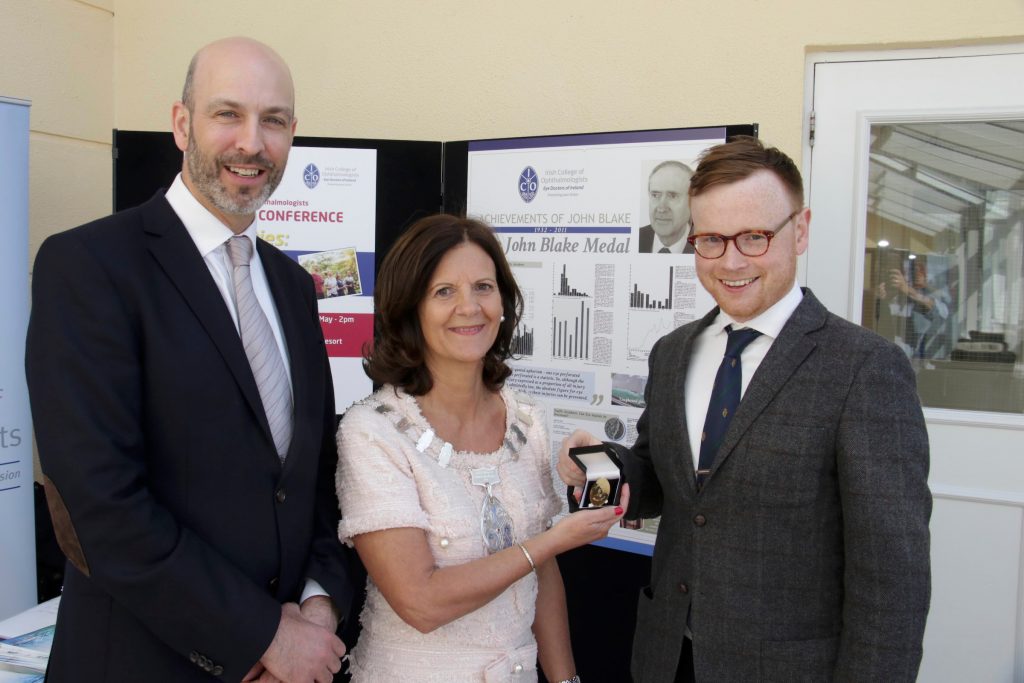Circadian variation in fluorescein signalling

Roibeard O’hEineachain
Published: Thursday, May 16, 2019
 ICO President Dr Alison Blake and Prof Conor Murphy present the inaugural John Blake Medal, named in honour of Dr Blake’s father, Consultant Ophthalmic Surgeon Mr John Blake, to Dr Alan Hopkins for the Best Scientific Laboratory Paper at the ICO Annual Conference 2019
Retinal blood-brain permeability appears to vary depending on the time of day, according to a study presented at the Irish College of Ophthalmology Annual Conference in Galway, Ireland.
“We have shown that in healthy volunteers undergoing fundus fluorescein angiography (FFA) there is a significant increase and more prolonged fluorescein signal in the evening compared to the morning,” said Alan Hopkins MD, Royal Victoria Eye and Ear Hospital, Dublin, Ireland.
The study involved 23 healthy human volunteers aged 18 to 30 who underwent quantitative in the morning and evening to assess for any changes in retinal vascular integrity. Fundal images were independently reviewed by a consultant ophthalmologist and Image +J analysis was used for quantification of FFA images.
The investigation showed that the fluorescein signal was more evident and more prolonged in the evening compared to the morning in the same subject and in all macular regions analysed (P < 0.001).
“An inner retina derived supply of systemically derived components to the photoreceptor outer segments and RPE has not been described previously and may represent a critically important physiological process central to the development of a range of retinopathies including age-related macular degeneration (AMD),” Dr Hopkins added.
ICO President Dr Alison Blake and Prof Conor Murphy present the inaugural John Blake Medal, named in honour of Dr Blake’s father, Consultant Ophthalmic Surgeon Mr John Blake, to Dr Alan Hopkins for the Best Scientific Laboratory Paper at the ICO Annual Conference 2019
Retinal blood-brain permeability appears to vary depending on the time of day, according to a study presented at the Irish College of Ophthalmology Annual Conference in Galway, Ireland.
“We have shown that in healthy volunteers undergoing fundus fluorescein angiography (FFA) there is a significant increase and more prolonged fluorescein signal in the evening compared to the morning,” said Alan Hopkins MD, Royal Victoria Eye and Ear Hospital, Dublin, Ireland.
The study involved 23 healthy human volunteers aged 18 to 30 who underwent quantitative in the morning and evening to assess for any changes in retinal vascular integrity. Fundal images were independently reviewed by a consultant ophthalmologist and Image +J analysis was used for quantification of FFA images.
The investigation showed that the fluorescein signal was more evident and more prolonged in the evening compared to the morning in the same subject and in all macular regions analysed (P < 0.001).
“An inner retina derived supply of systemically derived components to the photoreceptor outer segments and RPE has not been described previously and may represent a critically important physiological process central to the development of a range of retinopathies including age-related macular degeneration (AMD),” Dr Hopkins added.
Tags: retina
Latest Articles
Simulators Benefit Surgeons and Patients
Helping young surgeons build confidence and expertise.
How Many Surgeries Equal Surgical Proficiency?
Internet, labs, simulators, and assisting surgery all contribute.
Improving Clinical Management for nAMD and DME
Global survey data identify barriers and opportunities.
Are Postoperative Topical Antibiotic Drops Still Needed?
Cataract surgeons debate the benefits of intracameral cefuroxime prophylaxis.
Emerging Technology for Detecting Subclinical Keratoconus
Brillouin microscopy shows promise in clinical studies.
Knowing Iris Repair: Modified Trifold Technique
Part eight of our series covers the modified trifold technique for large iris defects.
It’s All About Biomechanics!
Increasing the pool of patients eligible for refractive surgery.
Uncovering More Safe and Quick Options
Different strategies, such as PresbyLASIK, can offer presbyopes good outcomes.
Topography-Guided PRK for Keratoconus
Improving visual acuity in patients with keratoconus.
Defining AMD Treatment Protocol
Treatments trending to fewer injections for better results.